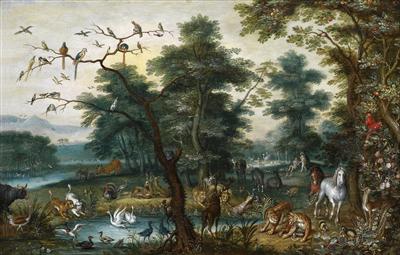Jan Brueghel II

(Antwerp 1601–1678)
Paradise scene with the Fall of Man,
oil on copper, 27 x 41.5 cm, framed
Provenance:
Belgian private collection.
Certificate:
Dr Klaus Ertz (September 2012).
Dr Ertz writes, “The state of preservation of this painting is extraordinarily good. The pigments used in this picture, which one can feel in relief with one’s fingertips, have a vivid, glowing appearance. They have been laid down thickly and in impasto, and are typical of the early stage of Jan Brueghel the Younger’s career, when he had just returned from his visit to Italy and had taken over the running of his father’s studio. [...] It is perhaps rather unfair to say that Jan Brueghel the Younger was overshadowed by his father during the latter’s lifetime. He demonstrates in this paradisiacal landscape that he was able to approach his father’s high level of attainment like no other artist of his day. On the death of his father, he took over his studio and continued to work in his unmistakeable style until the early 1630s. It was only after this time that he found his own style, which differs markedly from that of his father, amongst other things due to the reduced tonality and the more summary treatment of details. In this picture of Paradise he is still evidently holding true to his father’s inheritance...” This painting takes the lead from a Paradise scene with the Fall of Man by Jan Brueghel I, executed in 1615, according to Ertz, which is today at Hampton Court Palace (see K. Ertz, Jan Brueghel der Ältere, Kritischer Katalog der painting, vol. II, Lingen 2008–2010, cat. no. 192). The painting by his son, which he dates to circa 1626, is compared by Ertz to the following works by the artist: 1. “Landscape with paradise group”, Staatliche Museen, Gemäldegalerie, Berlin (circa 1620); 2. “Paradise landscape with the Fall of Man”, Szémüveszéti Muzeum, Budapest (circa 1620); and 3. “Paradise landscape with the Fall of Man,” Museo del Prado, Madrid (circa 1626).
The painting is a vivid example of the major artistic significance of Jan Brueghel the Younger’s works. Klaus Ertz writes, “After his father’s death and on taking over his studio, he painted works that were perfect both technically and artistically, which one finds it hard to distinguish from those of his father today. It is assuredly the case that the son was the artist who most consistently and at the highest level continued the father’s work.”
Specialist: Dr. Alexander Strasoldo
 Dr. Alexander Strasoldo
Dr. Alexander Strasoldo
+43-1-515 60-556
alexander.strasoldo@dorotheum.at
17.04.2013 - 18:00
- Realized price: **
-
EUR 122,300.-
- Estimate:
-
EUR 70,000.- to EUR 80,000.-
Jan Brueghel II
(Antwerp 1601–1678)
Paradise scene with the Fall of Man,
oil on copper, 27 x 41.5 cm, framed
Provenance:
Belgian private collection.
Certificate:
Dr Klaus Ertz (September 2012).
Dr Ertz writes, “The state of preservation of this painting is extraordinarily good. The pigments used in this picture, which one can feel in relief with one’s fingertips, have a vivid, glowing appearance. They have been laid down thickly and in impasto, and are typical of the early stage of Jan Brueghel the Younger’s career, when he had just returned from his visit to Italy and had taken over the running of his father’s studio. [...] It is perhaps rather unfair to say that Jan Brueghel the Younger was overshadowed by his father during the latter’s lifetime. He demonstrates in this paradisiacal landscape that he was able to approach his father’s high level of attainment like no other artist of his day. On the death of his father, he took over his studio and continued to work in his unmistakeable style until the early 1630s. It was only after this time that he found his own style, which differs markedly from that of his father, amongst other things due to the reduced tonality and the more summary treatment of details. In this picture of Paradise he is still evidently holding true to his father’s inheritance...” This painting takes the lead from a Paradise scene with the Fall of Man by Jan Brueghel I, executed in 1615, according to Ertz, which is today at Hampton Court Palace (see K. Ertz, Jan Brueghel der Ältere, Kritischer Katalog der painting, vol. II, Lingen 2008–2010, cat. no. 192). The painting by his son, which he dates to circa 1626, is compared by Ertz to the following works by the artist: 1. “Landscape with paradise group”, Staatliche Museen, Gemäldegalerie, Berlin (circa 1620); 2. “Paradise landscape with the Fall of Man”, Szémüveszéti Muzeum, Budapest (circa 1620); and 3. “Paradise landscape with the Fall of Man,” Museo del Prado, Madrid (circa 1626).
The painting is a vivid example of the major artistic significance of Jan Brueghel the Younger’s works. Klaus Ertz writes, “After his father’s death and on taking over his studio, he painted works that were perfect both technically and artistically, which one finds it hard to distinguish from those of his father today. It is assuredly the case that the son was the artist who most consistently and at the highest level continued the father’s work.”
Specialist: Dr. Alexander Strasoldo
 Dr. Alexander Strasoldo
Dr. Alexander Strasoldo
+43-1-515 60-556
alexander.strasoldo@dorotheum.at
|
Buyers hotline
Mon.-Fri.: 10.00am - 5.00pm
old.masters@dorotheum.at +43 1 515 60 403 |
| Auction: | Old Master Paintings |
| Auction type: | Saleroom auction |
| Date: | 17.04.2013 - 18:00 |
| Location: | Vienna | Palais Dorotheum |
| Exhibition: | 06.04. - 17.04.2013 |
** Purchase price incl. charges and taxes
It is not possible to turn in online buying orders anymore. The auction is in preparation or has been executed already.
